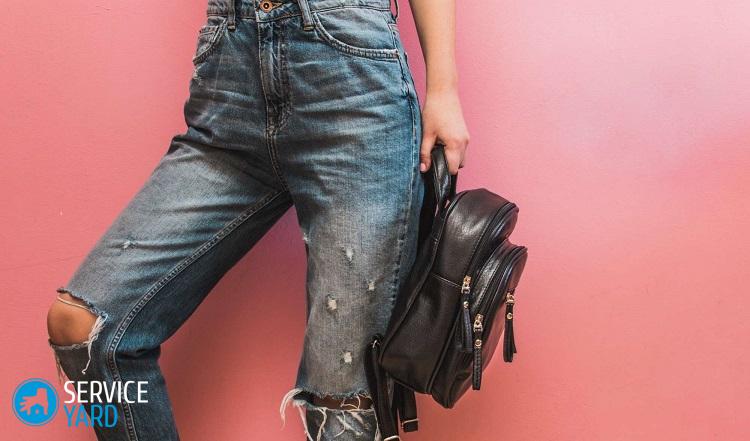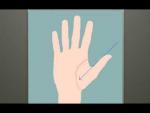Jeans are fraying between the legs - what to do?
Jeans are comfortable clothes that can be easily combined with many things and various shoes. For most people, this is the most favorite and frequently used part of their wardrobe. During prolonged wear, the bottom of the trouser legs becomes damaged, which is not so difficult to restore. Probably every third person has a problem when their jeans rub between their legs, what to do in such a situation? Does the duration of wearing jeans depend on their cost, brand, style? Is there anything that can be done to stop those chafed areas between the legs from appearing so quickly? These questions are asked quite often on forums. In response, someone advises not to skimp and buy more expensive jeans, someone advises to put on a leather pad in advance, like cowboys, and someone recommends losing weight. We will try to understand the reasons for this unpleasant situation and offer you different options for solving the problem, how to repair or restore jeans that have come apart between your legs.
Why are my jeans rubbing between my legs? What should I do?
Why do my jeans tear between my legs, what should I do? There may be several reasons for this problem:
- According to most experts, holes between the legs are rubbed due to the characteristics of the figure, and first of all, the upper part of the legs. If your legs do not close closer to the crotch (like a cavalryman), then your pants will remain intact.
Important! The fuller your thighs, the more often you go to the store for a new pair of jeans.
- Excess weight is very important, especially if it affects the volume of the hips. When the fabric is stretched, it wipes much faster. In some places, folds of tissue form between the legs, which constantly rub against each other when walking.
Important! This also happens to people who, through exercise, have developed bulky muscles in this area of the thigh.
- Often the cause of this problem is gait patterns. When, when walking, a leg rubs strongly against the other leg, it creates holes between the legs. Although in this situation, the crotch seam is wiped first, not the folds.
- The quality of the fabric also matters. Thin denim will quickly become unusable, especially jeans models that already have scuffs. As practice shows, denim fabric with the addition of polyester and elastane will be a little stronger. Although this, of course, is not a panacea for thinning tissue in certain places.
- The habit of fidgeting when sitting also means a lot. If for most of the working day your butt is fused with the office chair (which is most often covered with hard textured fabric), then when you change position you simply rub against its surface.
- It also affects the wear rate of the jeans fabric and the correctness of washing.
What can you do to prevent your pants from rubbing between your legs?
What can you do to extend the life of your favorite jeans? There are several secrets that can prevent unpleasant abrasions from occurring.
When you buy a new pair of pants, knowing about your ongoing problem, choose the right size. The trouser legs should not be too tight. Better buy jeans that are a little larger.
If you feel that you are overweight, try to lose it, it will benefit not only new jeans, but also your health. If there is excessive fullness in the lower part of the body, no pants will last long.

As practice shows, pants with a normal or even slightly high rise are less likely to wear out. When the jeans are well pulled up and fixed, the fabric does not gather in folds in the crotch, and therefore there will be no frayed stripes and holes. So when choosing a new pair, try to avoid low-waisted models.
When working sedentarily, try to control your movements. If you want to extend the life of your jeans, then when changing the position of your lower body, you need to rise a little, change your position and sit down again. This will reduce the intensity of friction slightly.
Important! To extend the life of the fabric, use less additives to the powder (conditioners, rinses, stain removers and bleaches). Treat stains locally, trying to avoid washing them with laundry soap.

Knowing your problem with jeans rubbing between your legs, monitor the condition of the fabric in the crotch area. As soon as it becomes thin, take it to the studio, do not wait for holes to appear. You can, of course, strengthen the fabric yourself; a little lower in the article we will tell you how to do this correctly. And in another post on our site you will find many interesting ideas that will in no way be restored to decent condition.
If jeans are your constant companion, buy yourself several pairs and wear them in turns. Some people buy 2 pairs of inexpensive models for daily wear and 1 pair “for going out”. Then you won’t have to deal with the problem of frayed holes in your pants so often.

What to do if your jeans are frayed between your legs?
A method that allows you to well camouflage a worn problem area and extend the life of jeans for a month, or even more, is to apply a patch to the inside and densely stitch the outside, imitating the interlacing of fabric threads. There are several ways to apply a patch to a damaged area of trousers. Let's look at each of them in detail.
We put a patch on it. Method No. 1
To implement this method you will need the following materials and tools:
- A patch made of soft, non-flowing fabric (for example, adhesive dublerin on a fabric basis).
- Durable sewing threads.
Important! Select threads that exactly match the tone of the denim, otherwise the repair area will be noticeable.
- A needle, scissors, chalk or a piece of soap for marking.

Procedure:
- Wash, dry and iron your jeans, especially the top, to remove wrinkles and creases.
- Turn your pants inside out.
- If there is a hole, carefully sew its edges by hand.
- From the fabric for the patch, cut out a piece of the required size and shape so that it completely covers the problem area. Add another 1-2 cm around the edges.
- If you are using adhesive dubbing, secure the patch to the fabric using an iron. If it is a simple fabric, secure it in the right place with a basting so that it does not move when sewing.
- Next, you need to turn the jeans inside out and lay the stitches parallel to the threads of the denim.
Important! It’s easier and faster to do this on a sewing machine.
- Start stitching from the place where the fabric is still intact.
Important! Place the lines very close to each other.

Important! You can do the same thing manually, with a needle and thread, but it will take much longer and may not look as neat.
If you don’t have a sewing machine at home and don’t want to work by hand, take your pants to a workshop. They will do everything quickly and professionally, but you will have to spend a little money, but the technician will be able to repair your jeans efficiently and professionally. In any case, it will cost much less than buying new jeans, and you will have time to spare to save up for a new thing.
We put a patch on it. Method No. 2
Jeans are torn between my legs, what should I do? This problem can be solved by making an insert to replace the worn fabric.

You will need:
- A piece of denim that is very similar in color and texture to your jeans.
- Threads: 1 - to match the jeans, 2 - to match the seam (usually yellow or orange).
- Needle, chalk or piece of soap, ruler.
- Scissors, steam ripper.
- Pattern paper (small piece) and pencil.

Procedure:
- Wash and iron your jeans and patch fabric until there are no wrinkles.
- Take a seam ripper (you can use nail scissors), rip the crotch seam and the middle seam to the middle or a little less.
- Make a chalk mark to determine which part you will cut (the damaged part should be completely outside the line).
- Using a ruler, draw straight lines on both legs symmetrically. Draw another line 1 cm further - the seam allowance.
- Cut along the first line. Cut the same piece on the second leg. Check that everything is the same, adjust.
- Attach the cut out flaps to the paper, trace with a pencil and make a pattern for the insert.
- Where the patch will be sewn to the jeans, allow a 1cm seam allowance.
- Apply this pattern to a piece of denim, trace with chalk and cut out.
- Position the part for the second leg mirror-like to the fabric.
Important! The edges of the inserts should be processed with a zigzag to prevent the threads from fraying.








 Nail care
Nail care Prom hairstyle for long hair
Prom hairstyle for long hair 18 wonderful New Year cards that even a child can make
18 wonderful New Year cards that even a child can make The best set of exercises for morning exercises
The best set of exercises for morning exercises